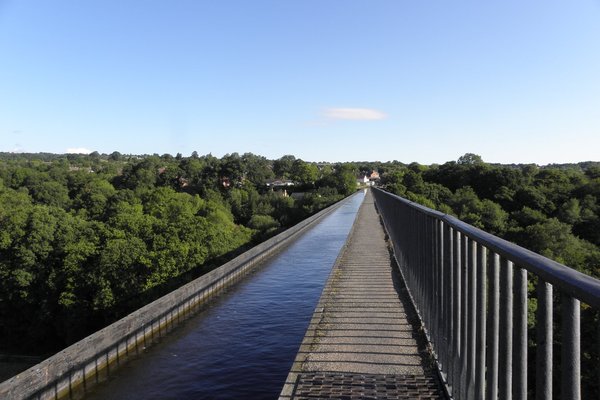United Kingdom
Pontcysyllte Aqueduct and Canal
The Pontcysyllte Aqueduct and Canal comprises an 18km stretch of canal, including a navigable aqueduct that is considered a masterpiece of civil engineering during the Industrial Revolution.
It was built by Thomas Telford and William Jessop, and completed in 1805. Innovative metal (cast iron) was used for the trough, while the pillars are made of brick. The aqueduct carries the Llangollen Canal over the valley of the River Dee in northeast Wales.
Community Perspective: Impressive for its height. It can be crossed on foot using the walkway next to the canal. Tsunami has described his visit to one of the additional components, Horseshoe Falls, and Squiffy covered Chirk.
Site Info
Official Information
- Full Name
- Pontcysyllte Aqueduct and Canal (ID: 1303)
- Country
- United Kingdom
- Status
-
Inscribed 2009
Site history
History of Pontcysyllte Aqueduct and Canal
- 2009: Inscribed
- Inscribed
- Type
- Cultural
- Criteria
- i
- ii
- iv
Links
- UNESCO
- whc.unesco.org
- Official
-
- pontcysyllte-aqueduct.co.uk — Pontcysyllte Aqueduct World Heritage
- Related
-
- news.bbc.co.uk — BBC Wales: A guide to the 11 mile route of Llangollen Canal designated a World Heritage Site, including Pontcysyllte Aqueduct
All Links
UNESCO.org
- whc.unesco.org — whc.unesco.org/
Official Website
- pontcysyllte-aqueduct.co.uk — Pontcysyllte Aqueduct World Heritage
Related Resources
- news.bbc.co.uk — BBC Wales: A guide to the 11 mile route of Llangollen Canal designated a World Heritage Site, including Pontcysyllte Aqueduct
News Article
- Jan. 24, 2023 businessnewswales.com — Wales World Heritage Site Awarded £13.3 Million for Visitor Improvements
- Feb. 5, 2019 wrexham.com — Visitor numbers quadruple in 10 years of Pontcysyllte Aqueduct World Heritage Site status
- Jan. 31, 2019 shropshirestar.com — Visitor numbers quadruple at Pontcysyllte aquaduct
- Jan. 9, 2015 shropshirestar.com — £ 1 million visitor centre idea for Pontcysyllte Aqueduct
- Jan. 4, 2012 bbc.co.uk — Plans to extend Pontcysyllte Aqueduct visitor centre
- Nov. 14, 2009 shropshirestar.com — Pontcysyllte Aqueduct is being drained and cleaned ahead of next year's tourist season
- Oct. 5, 2009 leaderlive.co.uk — Public celebration held for Pontcysyllte Aqueduct world heritage status
- Aug. 6, 2009 shropshirestar.com — A major event is being held to celebrate Britain's newest World Heritage site - the Pontcysyllte Aqueduct and Canal
Community Information
- Community Category
- Human activity: Transport and Trade
Travel Information
Free entrance
Not for Acrophobes
WHS Commandments Stars
Wales hotspot
Recent Connections
-
Perfect Inscriptions
2009 -
WHS Commandments Stars
Has all except #8, a nice ticket, but f… -
Not for Acrophobes
Footpath along the canal: "there are ra…
Connections of Pontcysyllte Aqueduct and Canal
- Individual People
-
-
Thomas Telford
Designed/Built by him in 1805.
-
- Geography
-
-
Linear inscriptions
"The nominated property consists of the whole length of the canal and its banks; 17km of its 18 km length is in Wales and 1km in England. It includes the towpath and adjacent buildings directly connected with its history" (AB)
-
- Trivia
-
-
Tourist Treks
Offa's Dyke is among the most popular long-distance walking routes in Europe. The Trail diverts onto the canal towing-path to Pontcysyllte Aqueduct. (nom file)
-
- Architecture
-
-
Iron Structures
"The trough was made from flanged plates of cast iron, bolted together" -
Georgian Architecture
Some purpose-built houses for the engineers like Scotch Hall and Wood Bank.
-
- World Heritage Process
-
-
Perfect Inscriptions
2009
-
- Human Activity
-
-
Festivals
Llangollen International Musical Eisteddfod
-
- Constructions
-
-
Tunnels
the Whitehouse tunnel and the Chirk tunnel -
Aqueduct
Pontcysyllte Aqueduct and Chirk Aqueduct -
Canals
-
Railways
Ruabon Brook Railway branch at Trevor Basin: Narrow-gauge railway track and siding on the west side of Trevor Basin for a railway-canal interchange. Plus Ruabon Brook Railway pier and Railway buildings, Bryn-Howel railway bridge, Plâs-Ifan Limestone Railway wharf and Sun Trevor limestone railway wharf, Chirk Railway Viaduct
-
- WHS on Other Lists
- Timeline
- WHS Hotspots
-
-
Wales hotspot
13km / 0.5 hour by bus
-
- Visiting conditions
-
-
Free entrance
You can walk on the aqueduct and along the canal for free. -
Not for Acrophobes
Footpath along the canal: "there are railings on the side with the path but there is no barrier on the other side, just a sheer drop from canal to the valley below" -
WHS Commandments Stars
Has all except #8, a nice ticket, but for a good reason, as its entrance is free
-
News
- businessnewswales.com 01/24/2023
- Wales World Heritage Site Awarded …
- wrexham.com 02/05/2019
- Visitor numbers quadruple in 10 ye…
- shropshirestar.com 01/31/2019
- Visitor numbers quadruple at Pontc…
Recent Visitors
Visitors of Pontcysyllte Aqueduct and Canal
- Adam Hancock
- Adrian Turtschi
- ailsa
- Alexander Lehmann
- Alex Goh
- alicemears
- Allan Berry
- A. Mehmet Haksever
- Ammon Watkins
- Andrew_Kerr
- Anna Wludarska
- Anne
- Argo
- Ask Gudmundsen
- Atila Ege
- awestix
- Badwater
- basementonline
- BaziFettehenne
- Brendan Carroll
- Carrascu
- Caspar
- CeeMon
- chenboada
- ChrisN
- christof
- Christravelblog
- Claire Bradshaw
- ClaraHH
- Clyde
- Colossus
- CugelVance
- Damientournay
- Daniel Chazad
- Danny L
- Dan Pettigrew
- David Scott King
- Dimitar Krastev
- Dorejd
- Doubanjiang
- Dr. Caligari
- Elaine McArdle
- Elis
- Elliot
- Els Slots
- emvcaest
- Erik Jelinek
- Errol Neo
- Eva Kisgyorgy
- Fan Yibo
- Femke Roos
- Filip Murlak
- finsbury_jo
- Frederik Dawson
- Gabbro
- Gary Arndt
- George Gdanski
- GeorgeIng61
- Gernot
- Grendel Gongan
- Harry Mitsidis
- Hubert
- Iain Jackson
- Ian Cade
- Ivan Rucek
- Jakob F.
- James Bowyer
- Janina Lehmann
- Jay T
- Jeanne OGrady
- Jesse S 2010
- Jezza
- João Aender
- Joel on the Road
- Jonas Hagung
- Jonas Kremer
- JR's HERITAGE SITES
- kathryn.park
- Kevin247
- Lara Adler
- Laurine
- leckie118
- Leonie Geurts
- Lithobates
- Luboang
- Luis Filipe Gaspar
- Luj3904
- Maciej Gil
- Martina Rúčková
- Matthewsharris
- MaYumin
- MH
- MichaelH
- Michael Turtle
- Mikko
- Ming_9734
- MMM
- nan
- Nihal Ege
- PabloNorte
- Patrik
- Paul Schofield
- Peter Lööv
- Petteri
- Philipp Leu
- Philipp Peterer
- Piotr Wasil
- Ralf Regele
- Randi Thomsen
- Rodinia
- rogerding
- Roger Ourset
- Roman Bruehwiler
- Rudegirl
- Sabrina Liebehentschel
- Samy G
- Schnitzel
- SDMArado
- Sergio Arjona
- Shandos Cleaver
- sibariam
- Solivagant
- Squiffy
- Squire Sullen
- Stanislaw Warwas
- Stefan A. Michelfeit
- Stijn
- Sturuss
- Svein Elias
- Szucs Tamas
- Tango
- Taotao Chen
- Tarquinio_Superbo
- Tevity
- TheTravelingRanger
- Thomas Buechler
- Thomas Harold Watson
- Thomas van der Walt
- Tom Flaten
- tony0001
- Tsunami
- Twobaconsandaboston
- usagi1974
- V&M
- Walter
- Wojciech Fedoruk
- Wo_ko
- Yongcheng Liu
- Zoë Sheng
- Александар Стојиљковић
Community Reviews
Show full reviews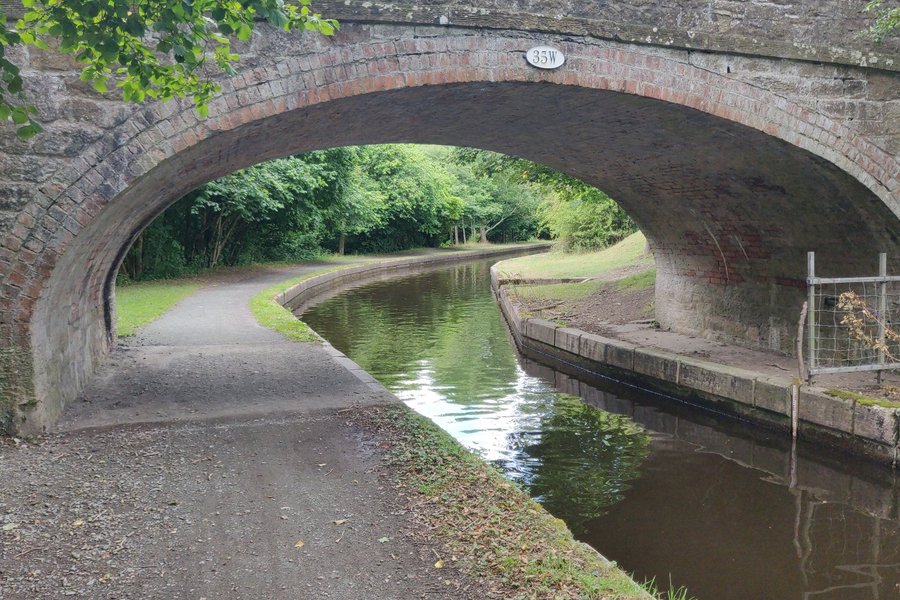
The Pontcysyllte aqueduct is visually impressive and walking on top as well as underneath it is an amazing experience. Having said that, the surrounding area shouldn't be missed.
Getting there by public transport
As this site is quite big, there are several options.
If you just want to see the aqueduct: Get off at Ruabon train station and take the bus to Trevor.
If you want to do a decent hike: Get off at Chirk train station and start walking from there.
By boat
Several different canal boat trips can be made. Kayaks can be rented.
Hiking
Once outside Chirk train station, walk southwards to the Chirk aqueduct and viaduct, and the Chirk Tunnel. Go down and start walking northwards along the Canal. Be sure to use your phone light to light your path in this and upcoming tunnels. Some are quite long and could be claustrophobic. As not many people do it this way, some of the paths might be a bit overgrown, but rest assured it's a very peaceful part of the trail with amazing sights and other than a handful of other hikers and the occasional local you won't encounter many people. Once you get closer to the actual aqueduct, it gets crowded. Facilities at the aqueduct are limited and the site itself isn't that big either. Half an hour is probably more than enough to walk around, and observe, take pictures. One could take the bus from here (from Trevor) to Ruabon train station, but it's …
Keep reading 0 comments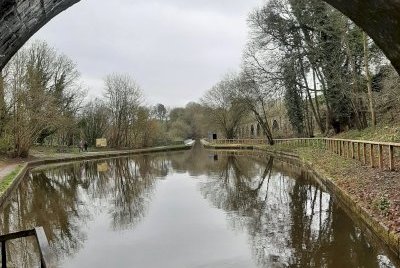
We were 20 metres above ground as we crossed the border. The wide valley of the turbulent River Ceiriog below tried its best to demarcate where England ended and Wales began, but it was no match for man’s ingenuity. As we walked the towpath of the Chirk Aqueduct there was a steady flow of Welsh water down the canal to our left, helping narrowboats navigate their way south into England. And just beyond it, a train nosed north over the Chirk Railway Viaduct where its journey between the English cities of Shrewsbury and Chester took it through Wales.
This was my third visit to Pontcysyllte Aqueduct and Canal – the third different area of the site and the first deliberate one. The site is a linear 11-mile stretch of what is now known as the Llangollen Canal, but was previously a branch of the Ellesmere Canal. My first was July 2009 when, in our early days of dating, my then girlfriend, knowing of my mild mania for all things UNESCO, brought me out to the newly-inscribed Pontycysyllte Aqueduct for a walk and a picnic. Reader, I married her. My second was again with her, but also with our 20-month-old son, on a sunny Summer day trip to the pleasant and touristy town of Llangollen. Put off by the price of a ride on the heritage steam railway we instead booked a trip on a horse-drawn boat up and down the narrow cutting from Llangollen Wharf. It wasn’t until …
Keep reading 0 comments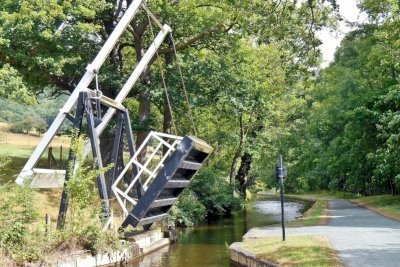
As other reviewers have noted, the name of this site is somewhat misleading as there is no such thing as the ‘Pontcysyllte Canal’. Rather then Pontcysyllte Aqueduct forms part of the Llangollen Canal, which is itself just a branch of the much larger Shropshire Union Canal. It was constructed at the turn of the 18th Century to transport coal, iron, and other goods needed in the early days of the Industrial Revolution. This was to have been part of the grand Ellesmere Canal to connect the River Mersey in the north with the River Severn in the south, joining the great port cities of Bristol and the ex-WHS Liverpool, but the full canal was never realised. Today, the Llangollen Branch runs from the town of Llangollen (not much surprise there) in north Wales to the tiny rural village of Hurleston in Cheshire, England where it joins the Shropshire Union. From there, goods could be shipped north through Chester to Ellesmere Port and the Mersey, which was later connected to the mills of Lancashire by the huge Manchester Ship Canal. Alternatively, turning south the canal eventually joins the endless maze of canals in the Midlands providing access to the great industrial metropolis of Birmingham, which is one of several places referred to as the ‘Venice of the North’ although perhaps less seriously so than Bruges, Amsterdam, etc.
Returning to the actual inscribed area, the first 11 miles of the Llangollen Branch forms the core zone out of the total length …
Keep reading 0 comments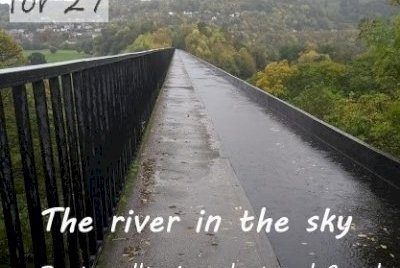
‘The river in the sky’ as it’s known is a marvel to behold, even in the pouring rain when I visited. I took a train to Ruabon then the number 5 bus to Trevor which drops you off about a ten minute walk from the aqueduct. Once there you can pop into the free and informative visitor’s centre which has a few videos and boards about the construction. After a decade of construction it opened in 1805 employing a cast iron trough to carry the five foot five inches deep canal 1007 feet (307 metres) across the River Dee which lies 127 feet (39 metres) below. It holds enough water to fill 16,000 baths.
But away from the facts, the aqueduct when you venture outside and go and see it is pure engineering magic of the highest degree. Picture this in your mind. You are walking along a gentle canal, nothing untoward, past houseboats and ducks, when up ahead you see that the land disappears but the canal doesn’t. It continues, without so much of a blip, across a valley to the other side far far away. All the time though, there is a perfect line of water suspended in a flat line. You could almost believe that the land either side of the water was dug away rather than the aqueduct constructed, until you spot the iron archways and stone supports grandly lifting the water high in the sky. It simply beggars belief. There is a narrow path …
Keep reading 0 commentsJakob F.
Pontcysyllte Aqueduct and Canal by Jakob Frenzel
Pontcysyllte Aqueduct and Canal (Inscribed)
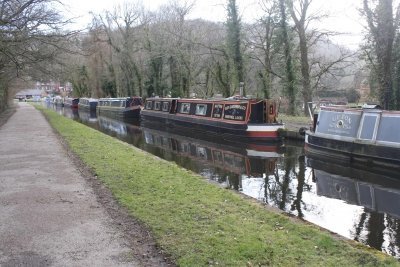
March 2018 - Fter visiting Ironbridge we came back to Wales and came closer to Pontcysyllte. Suddenly we were in in Trevor. There was a free car park and due to grey clouds we quickly started or tour to the Aquaduct. Walking over it is quite amazing, and to see the boats on it is very obscure. we walked a little further to see the next lift and then all way back. The historic boats make it an authentic visit.
Afterwards we followed the canal by car to Llangollen and made another stop at the wharf.
Keep reading 0 comments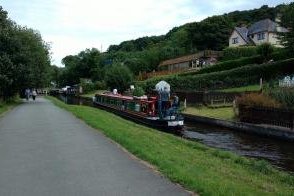
First things first, travelling in Wales made me feel like I was back in elementary school: “Could you repeat that?” was a common reply to me trying my utmost best to pronounce any place name. For the Pontcysyllte Aqueduct I eventually settled on referring to it simply as The Aqueduct. That worked splendidly.
Coming from the bus stop I made my way across rather quiet Trevor town. The aqueduct is not directly visible as you are on the upper plateau. So it’s a bit of a surprise when it suddenly gets busy and you get to see the aqueduct standing majestically in the landscape with the Severn flowing way below you.
Another surprise was the width of the canal on the aqueduct. I anticipated it to be way wider than it actually was. As a consequence, the barges travelling along the canal are very narrow, albeit quite long, and have a unique look. What they don’t have is much speed. So walking at a bit more than leisurely pace will allow you to overtake most of them. But the views you get from the aqueduct are stunning, so I paused frequently taking yet another picture and having the barges pass me by.
Getting There and Around
The closest train station is Ruabon (Ru-a-bon as I pronounced it was clearly wrong). From there buses run to Trevor (direction Llangollen). Be advised that some buses do not stop in front of the train station in Ruabon, but …
Keep reading 0 comments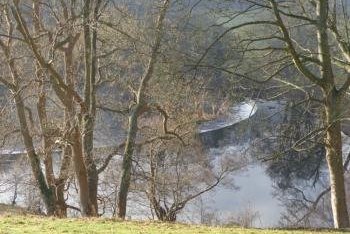
Again, I'm not sure why I have been so fascinated with canals lately, but I went back to the Llangollen Canal WHS on the 4th week of January to see one of the main components of this site, that is the Horseshoe Falls.
In order to do so, I decided to stay overnight in the town of Llangollen, which surprised me as soon as my bus from Wrexham entered the town.
The whole area around Llangollen constitutes "one huge outdoor adventure playground" with hiking trails, one of which leads to the Horseshoe Falls. I took the trail along the Llangollen Canal and the River Dee to the Falls. In fact I'd have to say it is the River Dee that makes the natural setting of the whole area so dynamic and beautiful.
You can also kayak on the river, take a narrow boat, even one drawn by a horse, on the canal, or take a Steam Locomotive (not in winter) between Llangollen and the Horseshoe Falls.
At the artificial Horseshoe Falls some water from the River Dee is diverted to feed the Llangollen Canal, the system designed by pioneering engineers William Jessop and Thomas Telford.
Later I also hiked up to the hill-top ruin of Castle Dinas Bran, where you get the 360-degree, sweeping view of the whole area all the way to the Pontcysyllte Aqueduct.
I am so glad that I went back to the area to see the Falls because, who knows, …
Keep reading 0 comments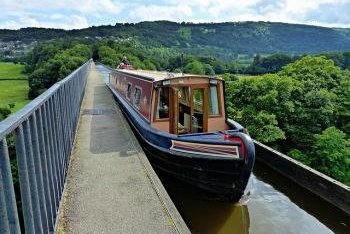
I visited this WHS in June 2016. I drove from Ironbridge and I arrived just before the last few boat trips which float through the Pontcysyllte Aqueduct marketed as the river in the sky. The boat trips' highlight is obviously the unique crossing over the aqueduct and the feeling of unease while standing to take pictures at a height of 38 metres (there are no safety railings on one side!). Another worthwhile boat trip experience at the Llangollen canal is the horse drawn boat trip should you have more time in the area. After visiting the Trevor Basin Visitor Centre (open 10am to 4pm), I enjoyed the heritage trail and after a quick photo of the bilingual UNESCO plaque in English and Welsh I drove to the nearby Chirk aqueduct before heading towards Harlech. This WHS reminded me of the Vizcaya Bridge in Spain and both were worthwhile WH visits. I look forward to visiting Forth bridge soon as well as the nearby river Clyde!
Keep reading 0 comments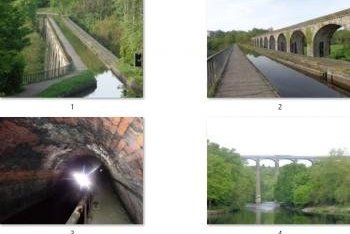
I visited the Chirk Aqueduct, the Chirk Tunnel, and the Pontcysyllte Aqueduct in May, 2016.
I took a train first from Chester (a beautiful city itself) to Chirk (where I had only 45 minutes between trains) to see the aqueduct and the tunnel. Then took a train back to Ruabon (where I had 2 hours between trains) to take a bus to Trevor to see the Pontcysyllte Aqueduct. And then took a bus back to Ruabon and a train back to Chester.
The photo 1 shows the Chirk Aqueduct. The photo 2 shows the Chirk Aqueduct for water and ship and the Chirk Viaduct for train. The photo 3 shows the Chirk Tunnel, where I came across a boat when I was walking through. The photo 4 shows the Pontcysyllte Aqueduct with 2 boats on it (although difficult to see in the photo).
Unfortunately, I didn't have time to visit the Horseshue Falls, where the Llangollen Canal starts off the River Dee.
I find it interesting that there are some people who live on the uniquely narrow boats on this canal.
I think there are terminology confusions in the "Brief Synthesis" and the "Map" at the UNESCO website. With the Brief Synthesis I believe the canal is called Llangollen Canal and not Pontcysyllte Canal. The bridge by Trevor is called Pontcysyllte Aqueduct. Pont means bridge anyway. The centerpiece of this WHS is the Pontcysyllte Aqueduct. The other tunnel, "Whitehouse Tunnel," used to appear as "Whitehurst …
Keep reading 0 comments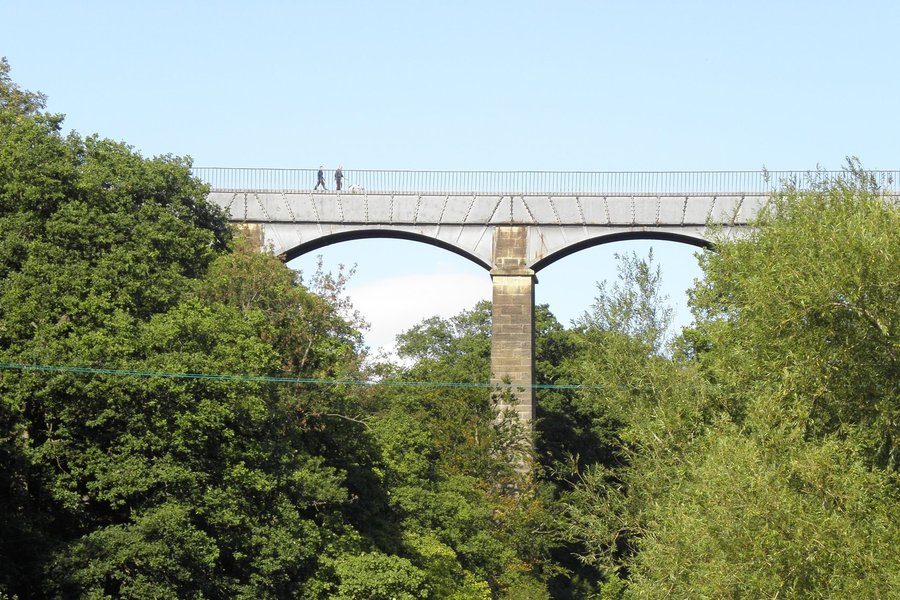
I went with my grandparents to Pontcysyllte in August 2013, having also visited around six years earlier - before it was inscribed in in 2009.
Pontcysyllte Aqueduct and Canal is deemed to be worthy of recognition because it is an early example of the ingenuity of the engineers and architects of the Industrial Revolution. Wales’s hilly terrain does not lend itself to the needs of canals, yet this section traverses the countryside without resorting to locks.
Conceived of and overseen by Thomas Telford, construction began in 1795 and was completed 10 years later. The bridge has withstood the test of time, with even the cast iron trough being the original one put in by Telford more than two centuries ago. The mortar is apparently made from lime, water and ox blood!
In addition to Pontcysyllte, I went to see the less famous Chirk aqueduct (also part of the inscription). It was completed four years earlier than Pontcysyllte and is now flanked by a railway bridge alongside it. From the aqueduct the canal goes quickly into a tunnel, which provides a clear reminder of just how undulous the terrain is. The landscape, formerly covered in foundries, brickworks and lime kilns, was described in Victorian times as “a vision of hell”. Nowadays that description couldn’t be further from the truth.
Keep reading 0 comments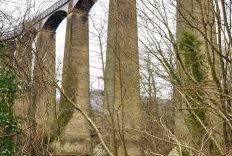
On the hourly 5A bus from Trevor to Wrexham in Northeastern Wales, I was wondering how UNESCO World Heritage program took me to this corner of United Kingdom to see the unknown aqueduct which I hardy could make a proper pronunciation or even spelling, an engineering masterpiece, the Pontcysyllte. I walked along the Llangolan canal until I reached the aqueduct passing many boats which were mooring waiting for the tourist season to begin in the next couple of months. The aqueduct was indeed impressive especially for its height from the River Dee, its column and ached bridges really remind me the equally impressive of ancient Roman aqueduct of Segovia in Spain. To appreciate the height of the bridge I decided to walk down to the River Dee level, but it was very exhausted when I had to walk back to the aqueduct level again. Then I crossed the Aqueduct, it was a nice design to have walkway on the bridge too, so that I could saw the waterway and the surrounding view. The view along the canal was also lovely but nothing special and some part was similar to another World Heritage Site in Belgium, the old Canal du Centre. I looked around the place together with 5-10 tourists for about 40 minutes and found out nothing I could do more in this place, so I hurry walked back to the bus stop to catch the bus back to Wrexham before continuing my trip to Conwy for another World heritage …
Keep reading 0 comments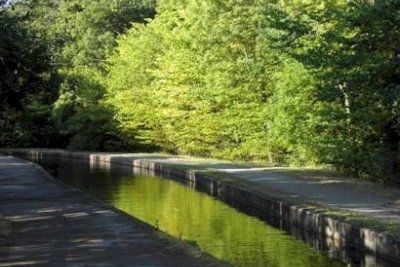
This essentially is one single structure, although the UK has included the whole canal and some features around it in the core zone of the nomination. But it's the formidable aqueduct why we all go here, and why it has earned worldwide recognition. I had spotted it from a distance the day before when crossing the very narrow old stone bridge in the valley on my way to Ironbridge.
I arrived at the aqueduct from the side of Trevor. After parking my car, I actually had to look around for a bit to search for the aqueduct: you're so high up here that you do not see the arches, but only the canal. I was early, at about 8.30 am, and had the sight completely to myself except for some joggers and curious squirrels. It is good to arrive early, as it gets very busy later in the day when coach loads are offloaded.
I walked to the other end via the foot path next to the canal. Fortunately, it has a sturdy railing so you do not really feel the height. Just over half of it the wind comes in, shaking you just a little (but enough to realize how tiny you are out in the open on this enormous structure). It is the first aqueduct that I have visited that you can actually walk on, and the narrow canal flowing next to you with no boundaries makes it an extra special experience.
After having walked …
Keep reading 0 comments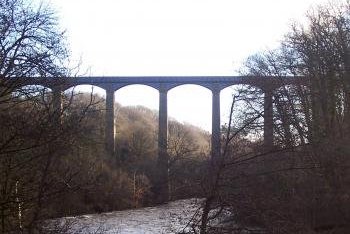
I paid the aqueduct a very unplanned visit in January 2008 whilst moving between Dublin and London. An early morning start from London led us to a great winter breakfast at Ironbridge Gorge. A drive further on led me through Llangollen, when suddenly a bell rung in my head that Pontcysyllte Aqueduct was located somewhere nearby. Fortunately a road sign turned up pointing us in the right direction.
As such my experience of this site was rather under researched and quick. I pulled up next to the start of the aqueduct to see that some early risers were readying their barges for the trip across it. I strolled out a short way and saw that it was a rather long way down.
After this I drove down to Horseshoe falls to get a view of the main span of the aqueduct. Unfortunately as I had a ferry to catch this was as much as I was able to see.
The route on to Holyhead (for the Dublin ferry) was fitting as Thomas Telford was instrumental in forging this link between what where then the two main cities of Britain. There are several Telford projects on this route, especially notable are the bridges at Conwy and across the Menai straights, which really add to the understanding of the infrastructure constructed during the industrial revolution.
My visit to Pontcysyllte Aqueduct was very brief and I am sure I will head back up there to appreciate it more in the near future. The …
Keep reading 0 comments
In order to avoid any potential charges that patriotic pride has outrun objective assessment I don’t normally review sites from UK! But with Pontcysyllte up for nomination this year I will break the rule. In any case it is from Wales, whose “turn” has come round again within the UK “rota” for nomination – rather than from my own country England. This means that most of you non-English speakers will find its name as difficult to pronounce as I do. This is the approximate way to do it apparently - “pont-kuss-uth-tay”.
We have been there a few times over the years. The Llangollen Canal, which is carried 38 metres over the valley of the river Dee by the aqueduct, passes through scenery which, in World or even European terms could best be described as “pleasant” in an understated rural way. If it wasn’t in Wales I would say it was quite “English” in character – indeed the modern “border” is only 5 kms away and the historic boundary of Offa’s Dyke is even less. The Dee still has a fair way to go upstream before it reaches the “real” Welsh mountains – though even these of course strain to reach 3000ft! But the spectacular crossing of the aqueduct which is available both by boat and on foot (photo) and the quiet delights of the Vale of Llangollen make this stretch one of the most popular stretches of canal in UK. Interestingly the extension of the canal up to Llangollen was …
Keep reading 0 comments
